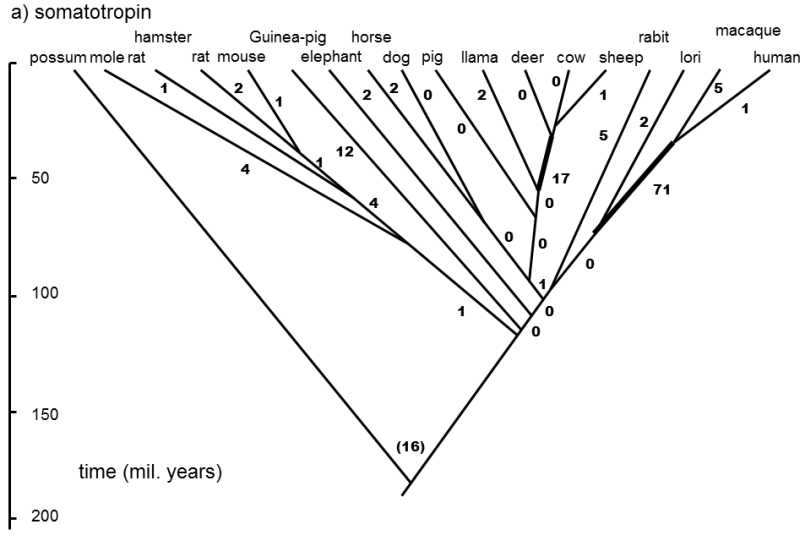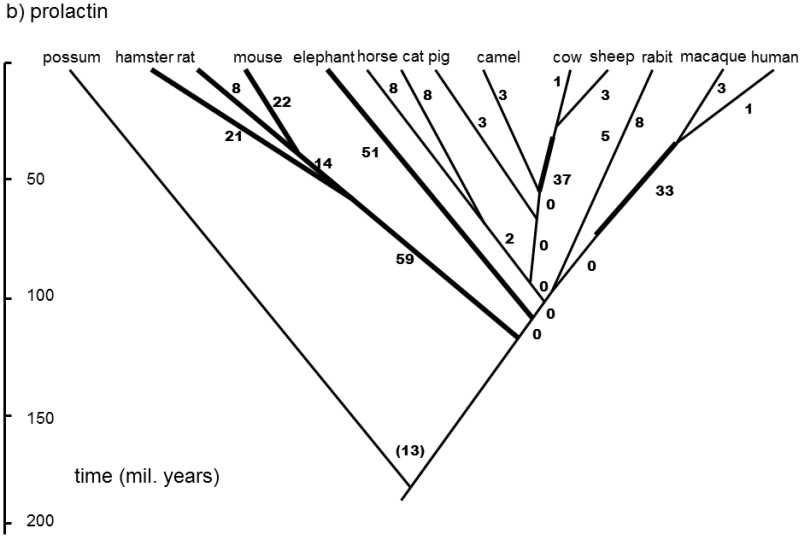IX.4.3 The substitution rate and the ratio of synonymous and non-synonymous mutations for different genes can change irregularly during evolution
The molecular clock is a stochastic clock.Thus, it cannot be expected that the constant number of mutations would be always fixed in a particular gene over the same time.However, if mutations were fixed mainly by genetic drift, the number of substitutions over time T in various species that diverged from a common ancestor at a certain moment should have Poisson distribution with an average of uT (where u is the mutation rate).The variation coefficient R(T), expressing the ratio of the variance and the average should thus be equal to 1.In actual fact, this variation coefficient is greater than 1 for most studied taxa (Ohta 1996; Kreitman 1996).This means that the rate of the molecular clock differs in time and for the individual lines more than would follow from the simple model of random accumulation of neutral mutations.Similarly, the ratio of fixed synonymous and nonsynonymous mutations fluctuates in time.
Study of changes in the substitution rate in the genes for 8 mammal hormones over a longer period of time actually demonstrated that this rate fluctuates substantially and highly irregularly for the individual genes (Wallis 2001)(Fig. IX.8).Overall, 62% of the substitutions in the genes occurred in a time


Fig. IX.8. Fluctuation of the rate of molecular evolution. Dendrograms show the progress of molecular evolution of sequences of somatotropin (a) and prolactin (b). The numbers correspond to the numbers of substitutions of aminoacids in the relevant molecules in the individual sections of the phylogenetic branch. It is apparent from the figure that evolution of the individual molecules occurs at different rates in the individual time intervals and in the individual developmental branches. The sections of rapid evolution are denoted by a thick line. According to Wallis (2001).
period encompassing only 15% of the monitored period.The substitution rate increased by up to 50x in some cases in a period of accelerated evolution.Simultaneously, the episodes of accelerated evolution did not agree in time for the individual proteins.These and similar results indicate that, when the molecular clock is used to study phylogeny, it is necessary to study the accumulation of mutations in several, where feasible in a great many genes, between which there is neither a genetic linkage nor a functional connection.
A number of theories have attempted to explain the great scatter in the rate of the molecular clock (Cutler 2000).It is most frequently assumed that most mutations are actually not neutral but slightly negative (see V.5).In this case, the substitution rate would be affected by a number of demographic factors and could fluctuate substantially over time.Other theories assume that changes in the mutation rate can occur in certain phases of development of a taxon or during a certain time period (Page & Holmes 2001).
